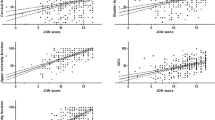Abstract
Although ossification of the posterior longitudinal ligament (OPLL) commonly develops in the cervical spine, it also occurs, albeit less commonly, in the thoracic spine. However, data are scarce regarding the characteristics of patients with thoracic OPLL. In the current study, we performed a cross-sectional study on a total of 133 patients with OPLL to clarify the clinical characteristics of patients with thoracic OPLL compared with those of patients with cervical OPLL. The subjects were divided into four groups according to the main region of OPLL and treatment type: C-OPLL-C, cervical OPLL treated conservatively; C-OPLL-S, cervical OPLL treated via surgery; T-OPLL-C, thoracic OPLL treated conservatively; and T-OPLL-S, thoracic OPLL treated via surgery. Symptoms developed at an earlier age in the T-OPLL-S group than in the C-OPLL groups. Current body mass index (BMI), maximum lifetime BMI, and BMI at the age of 20 years were significantly higher in the T-OPLL-S group than in the C-OPLL groups. Yearly weight gain from the age of 20 years to the age at which maximum body weight was attained was significantly greater in the T-OPLL-S group than in the C-OPLL groups. The T-OPLL group showed a higher rate of co-existence of OPLL at other regions or ossification of the ligamentum flavum compared to the C-OPLL groups. Our findings demonstrate that severe obesity, early-onset of symptoms, and diffuse ossification of spinal ligaments are distinct features of patients with myelopathy caused by thoracic OPLL.

Similar content being viewed by others
References
Ohtsuka K, Terayama K, Yanagihara M, Wada K, Kasuga K, Machida T, Matsushima S (1987) A radiological population study on the ossification of the posterior longitudinal ligament in the spine. Arch Orthop Trauma Surg 106:89–93
Yoshimura N, Nagata K, Muraki S, Oka H, Yoshida M, Enyo Y, Kagotani R, Hashizume H, Yamada H, Ishimoto Y, Teraguchi M, Tanaka S, Kawaguchi H, Toyama Y, Nakamura K, Akune T (2014) Prevalence and progression of radiographic ossification of the posterior longitudinal ligament and associated factors in the Japanese population: a 3-year follow-up of the ROAD study. Osteoporos Int 25:1089–1098
Matsunaga S, Sakou T (2012) Ossification of the posterior longitudinal ligament of the cervical spine: etiology and natural history. Spine 37:E309–314
Kim TJ, Bae KW, Uhm WS, Kim TH, Joo KB, Jun JB (2008) Prevalence of ossification of the posterior longitudinal ligament of the cervical spine. Jt Bone Spine 75:471–474
Ohtsuka K, Terayama K, Yanagihara M, Wada K, Kasuga K, Machida T, Furukawa K (1986) An epidemiological survey on ossification of ligaments in the cervical and thoracic spine in individuals over 50 years of age (in Japanese). Nihon Seikeigeka Gakkai Zasshi (J Jpn Orthop Assoc) 60:1087–1098
Shingyouchi Y, Nagahama A, Niida M (1996) Ligamentous ossification of the cervical spine in the late middle-aged Japanese men. Its relation to body mass index and glucose metabolism. Spine 21:2474–2478
Kobashi G, Washio M, Okamoto K, Sasaki S, Yokoyama T, Miyake Y, Sakamoto N, Ohta K, Inaba Y, Tanaka H, Japan Collaborative Epidemiological Study Group for Evaluation of Ossification of the Posterior Longitudinal Ligament of the Spine Risk (2004) High body mass index after age 20 and diabetes mellitus are independent risk factors for ossification of the posterior longitudinal ligament of the spine in Japanese subjects: a case-control study in multiple hospitals. Spine 29:1006–1010
Washio M, Kobashi G, Okamoto K, Sasaki S, Yokoyama T, Miyake Y, Sakamoto N, Ohta K, Inaba Y, Tanaka H, Japan Collaborative Epidemiological Study Group for Evaluation of Ossification of the Posterior Longitudinal Ligament of the Spine Risk (2004) Sleeping habit and other life styles in the prime of life and risk for ossification of the posterior longitudinal ligament of the spine (OPLL): a case-control study in Japan. J Epidemiol 14:168–173
Ministry of Health, Labor and Welfare (2017) National Health and Nutrition Survey. https://www.mhlw.go.jp/content/10904750/000351576.pdf
Kobashi G, Ohta K, Washio M, Okamoto K, Sasaki S, Yokoyama T, Miyake Y, Sakamoto N, Hata A, Tamashiro H, Inaba Y, Tanaka H, Japan Collaborative Epidemiological Study Group for Evaluation of Ossification of the Posterior Longitudinal Ligament of the Spine Risk (2008) FokI variant of vitamin D receptor gene and factors related to atherosclerosis associated with ossification of the posterior longitudinal ligament of the spine: a multi-hospital case-control study. Spine 33:E553–E558
Imagama S, Ando K, Takeuchi K, Kato S, Murakami H et al (2018) Perioperative complications after surgery for thoracic ossification of posterior longitudinal ligament: a nationwide multicenter prospective study. Spine 43:E1389–1397
Mori K, Imai S, Kasahara T, Nishizawa K, Mimura T, Matsusue Y (2014) Prevalence, distribution, and morphology of thoracic ossification of the posterior longitudinal ligament in Japanese: results of CT-based cross-sectional study. Spine 39:394–399
Ono M, Russell WJ, Kudo S, Kuroiwa Y, Takamori M, Motomura S, Murakami J (1982) Ossification of the thoracic posterior longitudinal ligament in a fixed population. Radiological and neurological manifestations. Radiology 143:469–474
Acknowledgement
The authors thank the patients with OPLL from Hokkaido prefecture of Japan for participating in the research. No funding or grant support was received for this study.
Author information
Authors and Affiliations
Contributions
TE: acquisition, analysis, and interpretation of data and drafting of the paper. MT: research design, acquisition, analysis, and interpretation of data and drafting of the paper. YK: acquisition, analysis, and interpretation of data. NI: interpretation of data.
Corresponding author
Ethics declarations
Conflict of interest
All authors have no conflicts of interest.
Additional information
Publisher's Note
Springer Nature remains neutral with regard to jurisdictional claims in published maps and institutional affiliations.
About this article
Cite this article
Endo, T., Takahata, M., Koike, Y. et al. Clinical characteristics of patients with thoracic myelopathy caused by ossification of the posterior longitudinal ligament. J Bone Miner Metab 38, 63–69 (2020). https://doi.org/10.1007/s00774-019-01026-8
Received:
Accepted:
Published:
Issue Date:
DOI: https://doi.org/10.1007/s00774-019-01026-8




